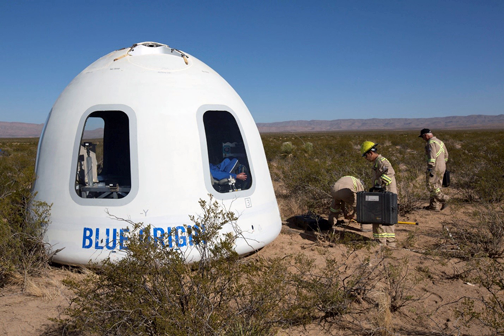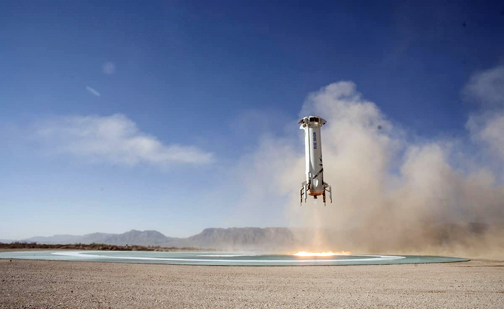On December 12, 2017, Blue Origin's New Shepard flew again for the seventh time — known as Mission 7 (M7), the flight featured the company's next-generation booster and the first flight of Crew Capsule 2.0.

Blue Origin's Crew Capsule 2.0 landed after the company's first successful commercial payload flight.
Photo is courtesy of Blue Origin.
While the primary objective was to progress testing this new system for human spaceflight, the company also achieved an exciting milestone with suborbital research in space by sending 12 commercial, research and education payloads under full FAA license for the first time. Payloads flying on New Shepard were engaged in important science and research onboard the 11 minute flight to space and back. During this flight, Blue Origin customers get approximately three minutes in a high-quality microgravity environment, at an apogee around 100 kilometers, making New Shepard ideal for microgravity physics, gravitational biology, technology demonstrations, and educational programs.

Blue Origin's New Shepard Mission 7 Booster Landing on December. Photo is courtesy of Blue Origin.
The combination of high altitude and low-gravity exposure provides an environment for a wide range of payloads ranging from basic and applied microgravity sciences to Earth and space science. Each of these domains has the opportunity to engage users ranging from universities to corporations. The rapid timelines and low costs of flight are also increasingly attracting educators and students of all ages.
Below are a few highlights of investigations that were a part of the New Shepard M7 flight:
-
Zero-Gravity Glow Experiment (ZGGE)
Purdue University & Cumberland Elementary School (West Lafayette, Indiana) in partnership with Arete STEM
The Zero-Gravity Glow Experiment, or ZGGE for short, was inspired by a second grade classroom’s question: “Can fireflies light up in space?” The payload operates by mixing the appropriate chemicals during the weightless coast period of the vehicle’s mission and observing the response with a miniature video camera.
-
DCS Montessori Middle School (Castle Pines, Colorado)
In Partnership with DreamUp
This payload was a collaboration across nearly 500 K-8 students and consisted of two parts. The first included an Arduino Nano microcontroller with a sensor package, designed and programed by the students to learn more about the environment inside the Crew Capsule. The second part contained a school-wide art project that all DCS Montessori students participated in. Upon landing, the data from the experiment will be analyzed and the art will be returned to the students and shared with the community.

